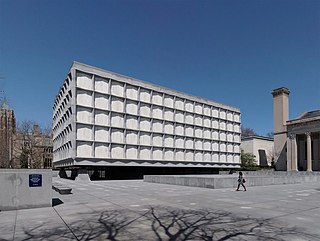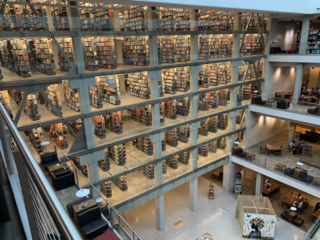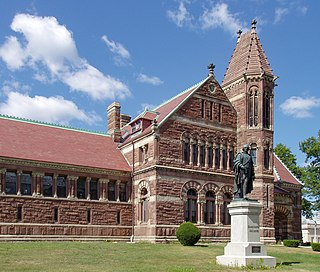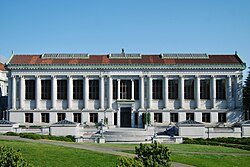
The Beinecke Rare Book & Manuscript Library is the rare book library and literary archive of the Yale University Library in New Haven, Connecticut. It is one of the largest buildings in the world dedicated to rare books and manuscripts and is one of the largest collections of such texts. Established by a gift of the Beinecke family and given its own financial endowment, the library is financially independent from the university and is co-governed by the University Library and Yale Corporation.
The Hilandar Research Library (HRL), located in the Thompson Library on the campus of Ohio State University, has the largest collection of medieval Slavic manuscripts on microform in the world.

Sterling Memorial Library (SML) is the main library building of the Yale University Library system in New Haven, Connecticut, United States. Opened in 1931, the library was designed by James Gamble Rogers as the centerpiece of Yale's Gothic Revival campus. The library's tower has sixteen levels of bookstacks containing over 4 million volumes. Several special collections—including the university's Manuscripts & Archives—are also housed in the building. It connects via tunnel to the underground Bass Library, which holds an additional 150,000 volumes.

The Bancroft Library is the primary special-collections library of the University of California, Berkeley. It was acquired from its founder, Hubert Howe Bancroft, in 1905, with the proviso that it retain the name Bancroft Library in perpetuity. The collection at that time consisted of 50,000 volumes of materials on the history of California and western North America. It is now the largest such collection in the world. The library's current building, the Doe Annex, is in the center of the university's main campus, and was completed in 1950.

The University House is a residence and venue for official events on the campus of the University of California, Berkeley. Designed by the architect Albert Pissis and completed in 1911, it was formerly named President's House while it served as the home of the president of the University of California, starting with Benjamin Ide Wheeler and ending with Robert Gordon Sproul. Since 1965, it has been the home of the Chancellor of the Berkeley campus.

The Doe Memorial Library is the main library of the University of California, Berkeley Library System. The library is named after its benefactor, Charles Franklin Doe, who in 1904 bequeathed funds for its construction. It is located near the center of the Berkeley campus, facing Memorial Glade, and is adjacent to and physically connected with the Bancroft Library. In 1900, Émile Bénard won an architectural competition for the design of the library, and the Neoclassical-style building was completed in 1911. The Doe Library building is the gateway to the underground Gardner (Main) Stacks, named in honor of David P. Gardner, the 15th President of the University of California.
The University of California operates the largest academic library system in the world. It manages more than 40.8 million print volumes in 100 libraries on ten campuses. The purpose of these libraries is to assist research and instruction on the University of California campuses. While each campus library is separate, they share facilities for storage, computerized indexing, digital libraries and management.

The James K. Moffitt Undergraduate Library, simply known as Moffitt Library, is a library situated at the crossroads of the University of California, Berkeley, designed by American activist John Carl Warnecke in the late 1960s as a cutting-edge library for undergraduates. Named after James K. Moffitt, a former Regent of the University of California, the library has been a popular destination for students for over four decades. Campus and curriculum changes in the time since Moffitt Library opened have been a catalyst for considering new purposes for this highly trafficked space. Accommodating increased undergraduate enrollments, greater focus on problem-based and research-based learning, and demand for access to technology-rich spaces have all been taken into account as part of the re-imagination of this library.
The campus of the University of California, Berkeley, and its surrounding community are home to a number of notable buildings by early 20th-century campus architect John Galen Howard, his peer Bernard Maybeck, and their colleague Julia Morgan. Subsequent tenures as supervising architect held by George W. Kelham and Arthur Brown, Jr. saw the addition of several buildings in neoclassical and other revival styles, while the building boom after World War II introduced modernist buildings by architects such as Vernon DeMars, Joseph Esherick, John Carl Warnecke, Gardner Dailey, Anshen & Allen, and Skidmore, Owings and Merrill. Recent decades have seen additions including the postmodernist Haas School of Business by Charles Willard Moore, Soda Hall by Edward Larrabee Barnes, and the East Asian Library by Tod Williams Billie Tsien Architects.

The William Oxley Thompson Memorial Library is the main library at Ohio State University's Columbus campus. It is the university's largest library and houses its main stacks, special collections, rare books and manuscripts, and many departmental subject libraries. The library was originally built in 1912, and was renovated in 1951, 1977, and 2009. It is named in honor of the university's fifth president, William Oxley Thompson.

Woburn Public Library, previously known as the Winn Memorial Library (1876–79) is a National Historic Landmark in Woburn, Massachusetts. Designed by architect H. H. Richardson, the Romanesque Revival building was a bequest of the Winn family. It houses the Woburn Public Library, an institution that was established in 1856. The library is also home to the Dr. Thomas J. Glennon Archives. The Glennon Archives holds many important records dating back to Woburn's early history in the 1600s. The Archives maintains more than two hundred separate manuscript collections relating to Woburn's history, several special collections of books including a rare book collection, tens of thousands of photographs, published genealogies, broadsides, maps, ephemera, and museum objects. Many of the Archives' museum objects can be viewed in the Historical Artifacts Room, located in the Octagon Room of the Richardson Building.

The Gerstein Science Information Centre is the University of Toronto's flagship library supporting the sciences and health sciences. The largest science and health science academic library in Canada, Gerstein has a collection of over 945,000 print volumes of journals and books, and also provides access to over 100,000 online journals and books. The Gerstein Science Information Centre's collection consists primarily of material on the sciences, including the health sciences, medicine, physics, chemistry, biology and their subfields, with the exception of mathematical journals and forestry, botany and geology materials. The library provides varying degrees of access to students, faculty, external researchers, and members of the public.

The Stephen A. Schwarzman Building is the flagship building in the New York Public Library system in the Midtown neighborhood of Manhattan in New York City. The branch, one of four research libraries in the library system, contains nine separate divisions. The structure contains four stories open to the public. The main entrance steps are at Fifth Avenue at its intersection with East 41st Street. As of 2015, the branch contains an estimated 2.5 million volumes in its stacks. The building was declared a National Historic Landmark, a National Register of Historic Places site, and a New York City designated landmark in the 1960s.

Marian Elliott "Bunny" Koshland was an American immunologist who discovered that the differences in amino acid composition of antibodies explain the efficiency and effectiveness with which they combat a huge range of foreign invaders.
The Institute of Governmental Studies (IGS) is an interdisciplinary organized research unit at UC Berkeley, located in Philosophy Hall. It was founded in 1919 as the Bureau of Public Administration. IGS and its affiliated centers spearhead and promote research, programs, seminars and colloquia, training, educational activities and public service in the fields of politics and public policy, with a strong focus on national and California politics. Current IGS research focuses include institutional policy and design, political reform, term limits, campaign finance, redistricting, direct democracy, presidential and gubernatorial politics, representative government, the politics of race and ethnicity, immigration and globalization.

Princeton University Library is the main library system of Princeton University. With holdings of more than 7 million books, 6 million microforms, and 48,000 linear feet of manuscripts, it is among the largest libraries in the world by number of volumes. The main headquarters of the university system is the Harvey S. Firestone Memorial Library building, named after tire magnate Harvey Firestone. Additionally, Princeton is part of the Research Collections and Preservation Consortium (ReCAP) along with Columbia Libraries, Harvard Library and New York Public Library.
The Oral History Center (ROHO) is part of The Bancroft Library at the University of California, Berkeley. The office was founded in 1954. ROHO conducts, analyzes, teaches about, and preserves oral history interviews on a wide range of topics related to the history of California and the United States. ROHO staff also conduct research on a wide range of historical topics, utilizing oral history as a central primary source to their scholarship.

Lamont Library, in the southeast corner of Harvard Yard in Cambridge, Massachusetts, houses the Harvard Library's primary undergraduate collection in humanities and social sciences. It was the first library in the United States specifically planned to serve undergraduates. Women were admitted beginning in 1967.

The Main Library is a historic library on the campus of the University of Illinois Urbana-Champaign in Urbana, Illinois. Built in 1924, the library was the third built for the school; it replaced Altgeld Hall, which had become too small for the university's collections. Architect Charles A. Platt designed the Georgian Revival building, one of several on the campus which he designed in the style. The building houses several area libraries, as well as the University Archives and the Rare Book & Manuscript Library. The Main Library is the symbolic face of the University Library, which has the second largest university library collection in the United States.
















